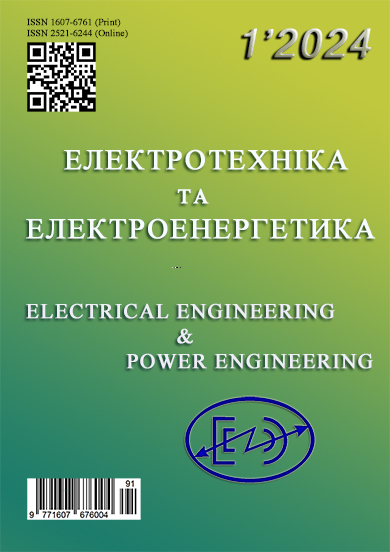Thermal processes in the heat exchange unit of a combined photovoltaic plant with solar radiation concentration
DOI:
https://doi.org/10.15588/1607-6761-2024-1-2Keywords:
solar cells, cooling, concentration, semiconductor, thermal energyAbstract
Purpose. Calculate the energy balance of a photo-energy installation for operation in conditions of concentrated solar radiation, develop the design of a heat exchange unit with "micro" channels.
Methodology. Analytical studies using criterion equations of hydrodynamics, creation and study of computer models based on heat balance equations.
Findings. Based on the analysis of thermal processes, the design of a heat exchange unit equipped with "micro channels" for a combined photoelectric plant designed to work in conditions of concentrated solar radiation is proposed. It is shown that such a design creates a transitional mode of cooling liquid flow, which allows for efficient cooling of solar cells under conditions of concentrated solar radiation. Based on the results of research, ways of improving the design of the heat exchange unit for equipping a photoelectric system designed to work in conditions of disruption of the typical energy infrastructure are proposed. It has been shown that in order to reduce the temperature difference over the SC area, the design of the heat exchange block can be optimized by moving the coolant inlet to the center and creating two exits at the opposite ends of the block.
Originality. For the first time, the design of the radiator of the heat exchange unit based on "micro-channels" was proposed, which provides a transitional mode of coolant flow with a heat exchange coefficient between the coolant and the upper plate of the radiator. hf ~ 10000 W/(m2K) at a flow speed in the gaps between the plates ~2.1 m/s.
Practical value. The evaluation of the efficiency, thermal and electrical characteristics of the combined photo-energy system with the concentration of solar radiation was performed. It is proposed to use the developed design of the heat exchange unit for equipping a photoelectric plant for operation in conditions of disruption of the typical energy infrastructure. A preliminary calculation of the thermal and electrical parameters of a photovoltaic installation equipped with multi-cascade solar cells based on gallium arsenide and a heat exchange unit with "microchannels" was carried out.
References
Rodziewicz T., Zaremba A., Wacławek M. (2016). Photovoltaics: Solar energy resources and the possibility of their use. Ecol. Chem. Eng. S., 23, 1, 9-32. DOI: 10.1515/eces-2016-0001
He, Y.-L., Qiu, Y., Wang, K., Yuan, F., Wang, W.-Q., Li, M.-J., & Guo, J.-Q. (2020). Perspective of concentrat-ing solar power. Energy, 198, 117373. DOI: 10.1016/j.energy.2020.117373
Geisz J.F., France R.M., Schulte K.L., et. al. (2020). Six-junction III-V solar cells with 47.1% conversion effi-ciency under 143 suns concentration. Nature Energy, 5, 326-335. DOI: 10.1038/s41560-020-0598-5
Vignesh N., Arunachala U.C., Varun K. (2023). Inno-vative conceptual approach in concentrated solar PV/thermal system using Fresnel lens as the concen-trator. Energy Sources, Part A, 45, 4, 10122-10143. DOI: 10.1080/15567036.2023.2242800
Herrando M., Wang K., Huang G., et. al. (2023). A review of solar hybrid photovoltaic-thermal (PV-T) collectors and systems. Progress in Energy and Combustion Science, 97, 101072. DOI: 10.1016/j.pecs.2023.101072
Papež N., Dallaev R., Ţălu Ş., Kaštyl J. (2021). Over-view of the Current State of Gallium Arsenide-Based Solar Cells. Materials, 14, 11, 3075. DOI: 10.3390/ma14113075
Duffie J.A., Beckman W.A. (2013). Solar Engineering of Thermal Processes. John Wiley & Sons Inc., 910. DOI:10.1002/9781118671603
Xu B., Xu J., Chen Z. (2020). Heat transfer study in solar collector with energy storage. International Journal of Heat and Mass Transfer, 156, 6, 119778. DOI: 10.1016/j.ijheatmasstransfer.2020.119778
Duta B.K. (2023). Heat Transfer: Principles and Appli-cations. PHI Learning Pvt. Ltd., 648.
Downloads
Published
How to Cite
Issue
Section
License
Copyright (c) 2024 G.S. Khrypunov, V.O. Nikitin, A.V. Meriuts, К.О. Minakova, R.V. Zaitsev, M.V. Kirichenko, T.M. Shelest, S.Yu. Leliuk

This work is licensed under a Creative Commons Attribution-ShareAlike 4.0 International License.
Creative Commons Licensing Notifications in the Copyright Notices
Authors who publish with this journal agree to the following terms:
Authors retain copyright and grant the journal right of first publication with the work simultaneously licensed under aCreative Commons Attribution License that allows others to share the work with an acknowledgement of the work's authorship and initial publication in this journal.
Authors are able to enter into separate, additional contractual arrangements for the non-exclusive distribution of the journal's published version of the work (e.g., post it to an institutional repository or publish it in a book), with an acknowledgement of its initial publication in this journal.
Authors are permitted and encouraged to post their work online (e.g., in institutional repositories or on their website) prior to and during the submission process, as it can lead to productive exchanges, as well as earlier and greater citation of published work.

